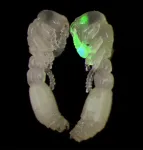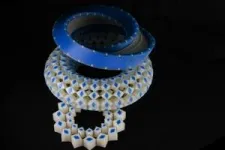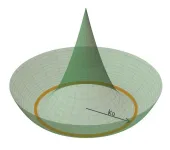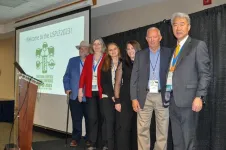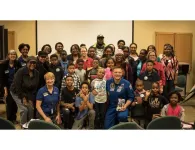(Press-News.org) Ants navigate their richly aromatic world using an array of odor receptors and chemical signals called pheromones. Whether foraging or defending the nest, mating or tending to their young, ants both send and receive chemical signals throughout their lives. The importance of this system is underscored by how well equipped the ant brain is to process the abundance of scents: The olfactory processing center in the ant’s brain has 10 times as many subdivisions as fruit flies do, for example, even though their brains are about the same size.
And yet how the ant olfactory system encodes scent data has remained largely unknown. To whittle away at the mystery, researchers from Rockefeller University have developed the world’s first transgenic ants, which have been bred with olfactory sensory neurons that flash green in response to odorants. They published their results in Cell.
Contrary to previous findings, the study found that only a few specific areas of the olfactory system lit up in response to alarm pheromones, danger signals that elicit panic and nest evacuation. The results raise questions about how sensory information is processed in the ant brain—as well as tantalizing possibilities for revealing what hundreds of other odorant receptors are up to.
“Neurogenetic tools have revolutionized the field of fruit fly neuroscience over the past decades, while social insect neuroscience has essentially been stuck,” says Rockefeller’s Daniel Kronauer, head of the Laboratory of Social Evolution and Behavior. “Our technical breakthroughs now finally allow us to apply these powerful tools in ants to study their social behavior.”
A world of odors
In 1958, E. O. Wilson reported that a secretion from the mandibular gland of harvester ants triggered their nestmates to quicken their pace and take up colony defense behaviors. He called this response “alarm behavior.” Since then, scientists have documented that alarm behavior and many other complex social activities in ant colonies are regulated by a vast array of pheromones.
Ants’ olfactory receptors are located on neurons in their antennae, which send their input to brain centers called the antennal lobes. The antennal lobes are comprised of specialized structures called glomeruli that are essential to scent processing. Some ants have more than 500 glomeruli—a bounty thought to be related to their heightened ability to perceive and discriminate between pheromones. Previous work from Kronauer’s lab has shown that ants whose odorant receptors have been knocked out cannot respond to pheromone signals.
In this study, the researchers created their transgenic subjects by injecting the eggs of clonal raider ants—a queenless species composed entirely of blind female workers—with genetic material encoding the synthetic protein GCaMP, which lights up neon green when calcium levels change during cellular activity.
“Our goal was to get GCaMP expressed only in a single cell type—the olfactory sensory neurons,” says lead author Taylor Hart, a researcher in Daniel Kronauer’s lab.
This was important because the antennal lobe is composed of multiple cell types: sensory neurons, projection neurons that carry sensory data to other parts of the brain, and lateral interneurons that link everything together. “Those other cell types can make signal-to-noise ratio poor, because they can be doing other activities, such as computations, processing information, and modulating signals,” Hart says. All of this can obscure what the olfactory neurons are doing.
Finding the panic button
While successfully breeding a small group of ants with GCaMP expression in the olfactory sensory neurons, the team also developed a sophisticated two-photon calcium imaging technique that allowed them to record neural activity throughout the entire antennal lobes of live ants for the first time.
The researchers decided to focus on alarm pheromones, because they are particularly volatile and elicit strong and robust behavioral responses. They found that adult ants that detected the scents immediately scrambled to gather as many eggs in their mandibles as they could and then made a break for it, fleeing into an adjacent section of the test chamber.
Hart and her team then used their new techniques to monitor GCaMP fluorescence levels in the antennal lobes of 22 transgenic ants as they exposed them to a range of odors, including the alarm pheromones (which smell fruity to the human nose). The flashes clustered in six glomeruli in one region, suggesting that area may act as the brain’s panic button.
“We were expecting that a large portion of the antennal lobe would show some kind of response to these alarm pheromones,” Hart says. “Instead, we saw that the responses were extremely localized. Most of the antennal lobe did not respond at all.”
Hart says the findings reveal details about how the ant brain processes sensory input. Researchers have wondered whether the activity is privatized, with each glomerulus responding only to one or a few specific stimuli, or distributed, with unique combinations of glomeruli activated by a stimulus. A brain with more than 500 glomeruli that operated in a distributed way, with hundreds of sensors firing at once, would need extraordinary computational power when it comes to sensory processing, Hart says.
“Most of the odors we tested activated only a small proportion of the total glomeruli,” she says. “It seems that privatization is the way in the ant antennal lobe.”
Tools for the future
Considering that only six glomeruli responded out of 500, Hart wonders, “What do they need all these different glomeruli for? The fruit fly gets by with just 50.”
It will now be easier to find out why ants have a greater need to differentiate odor stimuli than other insects, Kronauer says—and not only because Hart has since bred hundreds of transgenic ants who differ from their wild counterparts only in their ability to signal in fluorescence, providing a robust pool for future research.
“The tools that Taylor developed open up a really big range of questions that were inaccessible to us until now,” he says. These include associating specific glomeruli with the variety of pheromones ants use for things like raiding, recruitment, and distinguishing between nestmates and outsiders. “There are also interesting developmental questions about how the ant olfactory system gets assembled, because it’s so complex. Larvae also have olfactory sensory neurons, so now we can look at their sensory capabilities.”
END
World’s first transgenic ants reveal how colonies respond to an alarm
2023-06-14
ELSE PRESS RELEASES FROM THIS DATE:
For experimental physicists, quantum frustration leads to fundamental discovery
2023-06-14
AMHERST, Mass. – A team of physicists, including University of Massachusetts assistant professor Tigran Sedrakyan, recently announced in the journal Nature that they have discovered a new phase of matter. Called the “chiral bose-liquid state,” the discovery opens a new path in the age-old effort to understand the nature of the physical world.
Under everyday conditions, matter can be a solid, liquid or gas. But once you venture beyond the everyday—into temperatures approaching absolute zero, things smaller than a fraction ...
Metamaterials with built-in frustration have mechanical memory
2023-06-14
Researchers from the UvA Institute of Physics and ENS de Lyon have discovered how to design materials that necessarily have a point or line where the material doesn’t deform under stress, and that even remember how they have been poked or squeezed in the past. These results could be used in robotics and mechanical computers, while similar design principles could be used in quantum computers.
The outcome is a breakthrough in the field of metamaterials: designer materials whose responses are determined by their structure rather than their chemical composition. To construct a metamaterial with mechanical memory, physicists ...
Earth was created much faster than we thought. This makes the chance of finding other habitable planets in the Universe more likely
2023-06-14
When we walk around in our everyday life, we might not think of the Earth itself very often. But this planet is the foundation of our life. The air we breathe, the water we drink and the gravity that pins us to the ground.
Up until now, researchers believed that it took more than 100 million years for the Earth to form. And it was also common belief that water was delivered by lucky collisions with water-rich asteroids like comets.
However, a new study from the University of Copenhagen suggests that it might not have happened entirely by chance.
“We show that the Earth formed by the very ...
A scorching-hot exoplanet scrutinized by UdeM astronomers
2023-06-14
An international team led by Stefan Pelletier, a Ph.D. student at Université de Montréal's Trottier Institute for Research on Exoplanets announced today having made a detailed study of the extremely hot giant exoplanet WASP-76 b.
Using the MAROON-X instrument on the Gemini-North Telescope, the team was able to identify and measure the abundance of 11 chemical elements in the atmosphere of the planet.
Those include rock-forming elements whose abundances are not even known for giant planets in the Solar System such as Jupiter or Saturn. The team's study is published in ...
A growing number of producers and industries interested in precision livestock farming
2023-06-14
Some of the world’s best minds that are focused on profitable and sustainable livestock production attended and presented at the recent Second U.S. Precision Livestock Farming Conference. Hosted by University of Tennessee AgResearch, the May 21-24 event at the UT Conference Center in Knoxville attracted 219 attendees representing 22 countries and 32 U.S. states. Participants included academics, representatives of government agencies and allied industries as well as producers. The conference had a central theme of “Field Application of PLF Technologies” and academic presentations along with two industry and producer panels included interactive dialogues among the attendees ...
It takes a village: Study shows community is key to a sustained passion for science among adolescents
2023-06-14
The results of a yearlong science program show that one of the best ways to instill a lasting interest in science among children is to engage them alongside their family members. This finding runs counter to the current framework, in which children attend science-related summer camps and after-school programs apart from their families, diminishing the long-term potential of what they learn.
“We wanted to see if we could support families as a whole, as opposed to giving a student a really amazing one-off experience and sending them ...
Racial disparities found in one of first studies of pharmacological treatment of insomnia
2023-06-14
INDIANAPOLIS — In one of the first studies to investigate racial disparities in the pharmacologic treatment of insomnia, researchers from Regenstrief Institute and Indiana University report that patients belonging to racial minority groups were significantly less likely to be prescribed medication following diagnosis of insomnia than White patients.
The study found that Black patients were much less likely to have been prescribed an FDA-approved insomnia medication at any time post diagnosis than White patients. Other non-White individuals were significantly less likely to be prescribed an FDA-approved medication two, three, and four years after insomnia diagnosis ...
New York Academy of Sciences, Leon Levy Foundation name first 10 Leon Levy Scholars in Neuroscience
2023-06-14
New York, NY, June 14, 2023 — The New York Academy of Sciences and the Leon Levy Foundation announced today the first cohort of Leon Levy Scholars in Neuroscience; a continuation of an earlier fellowship program started by the Foundation in 2009 that has supported 160 fellows in neuroscience.
This highly regarded postdoctoral program supports exceptional young researchers across the five boroughs of New York City as they pursue innovative investigations in neuroscience and advance in their careers toward becoming independent principal investigators. Designed to broaden the field and to support researchers who might otherwise not ...
Cancer researchers focused on bringing new discoveries to patients get two-year funding awards
2023-06-14
June 14, 2023, TORONTO — Funding announced today by the Ontario Institute for Cancer Research (OICR) will help six Ontario-based research teams pursue their ultimate goal of improving the lives of people with cancer.
Funding comes through OICR’s Innovation to Implementation (I2I) program, which aims to help ensure new discoveries about preventing, diagnosing and treating cancer are adopted into healthcare policy and clinical practice.
“Every cancer researcher wants their work to have ...
Dr. Jonathan Weinsaft named chief of the Greenberg Division of Cardiology at Weill Cornell Medicine and NewYork-Presbyterian/Weill Cornell Medical Center
2023-06-14
NEW YORK (June 14, 2023)— Dr. Jonathan Weinsaft, an esteemed physician-scientist who focuses on clinical research and cardiovascular imaging, has been appointed chief of the Greenberg Division of Cardiology at Weill Cornell Medicine and NewYork-Presbyterian/Weill Cornell Medical Center, effective July 1.
The Greenberg Division of Cardiology, housed within the Weill Department of Medicine, is dedicated to diagnosing and treating patients with disorders of the heart and blood vessels that comprise the cardiovascular system.
In his new role, Dr. Weinsaft will further strengthen the division as a leader in scientific and technological ...
